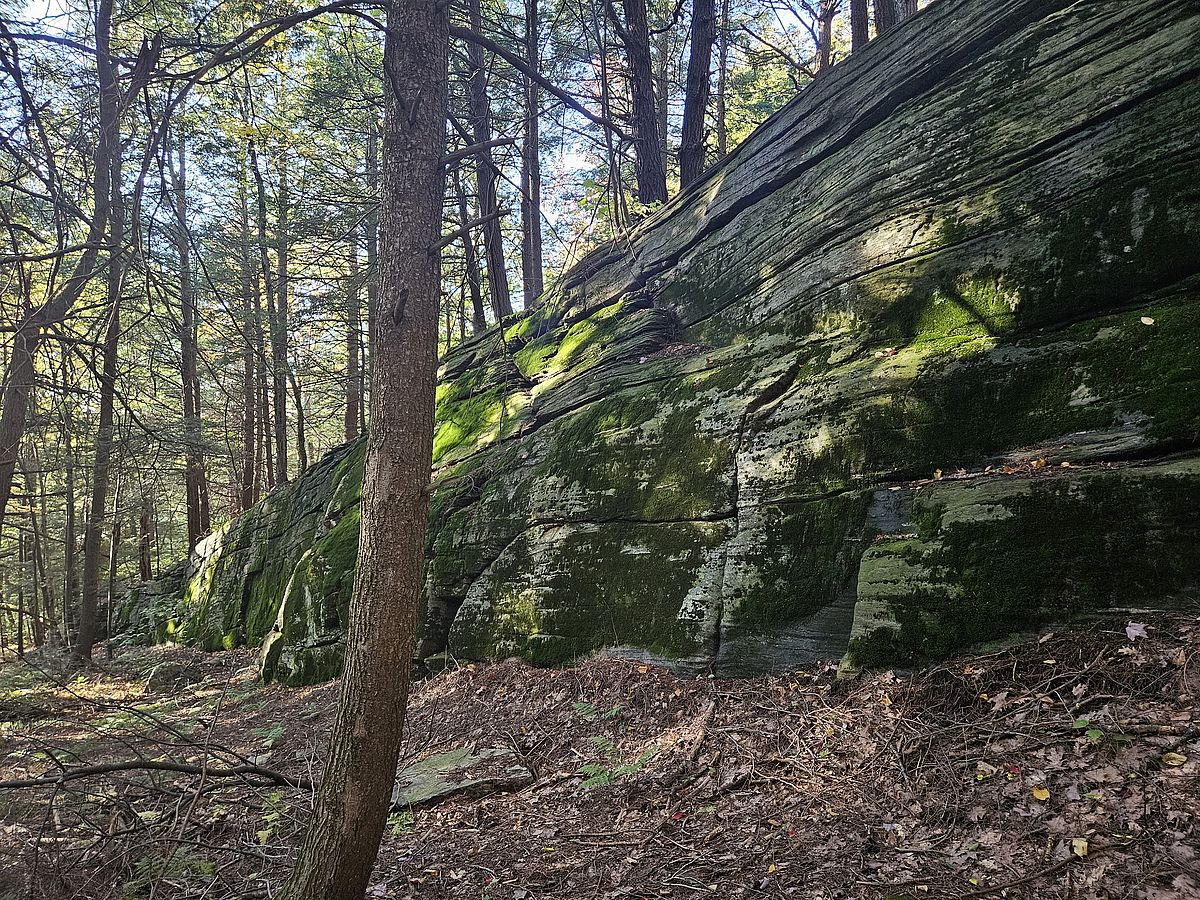Mt. Hunger at Konkapot Ridge
Konkapot Ridge is named for tribal leader, John Konkapot, and the connection of the Mohican people to their homelands. The Mt. Hunger trail provides vistas and a wooded ridgeline with interesting rock formations.
Highlights
- Tyringham, MA
- 1.4 miles, round trip
- Difficulty: Moderate
- Size: 1,728 acres
- Special features: Part of the Berkshire Wildlife Linkage
Difficulty
This land, and all of the present-day Berkshires, are the ancestral homeland of the Mohican people, who were forcibly displaced to Wisconsin by European colonization. These lands continue to be of great significance to the Stockbridge-Munsee Mohican Nation today. To learn more, visit mohican.com.
Directions & Parking
GPS
- Trailhead Parking: Google Maps | 42.1942, -73.1907
From Lee
From the junction of Routes 102 and 20 and the Mass Pike in Lee, take the 5-mile drive south on Tyringham Road. Turn right onto the Monterey/Tyringham Road. Drive past BNRC’s Steadman Pond Reserve and take the next left on Mt. Hunger Road. Parking for Mt. Hunger is on Mt. Hunger Road about 0.5-miles south of the intersection with Monterey/Tyringham Road.
From Monterey
Head north on Tyringham Road for 1.5 miles, then turn right onto Mt. Hunger Road. Parking for Mt. Hunger is on Mt. Hunger Road about 0.5-miles south of the intersection with Monterey/Tyringham Road.
Trail Description
Mt. Hunger Trail: 1.4 miles, round trip
Blue blazes guide you along the out-and-back trail with a gradual elevation change of about 240 feet and views of Tyringham Valley, Tyringham Cobble, and the Catskill Mountains.
Steadman Pond at Konkapot Ridge is nearby and offers a short walk to a scenic pond.
About the Reserve
The 1,728 acres of protected land that make up Konkapot Ridge Reserve offer a variety of habitat, which is crucial for the movement of species. The place name Konkapot Ridge recognizes tribal leader, John Konkapot, and the deeply rooted connection of the Mohican people to their homelands
This reserve is part of the Berkshire Wildlife Linkage, a significant wildlife corridor spanning from Vermont’s Green Mountains to the Hudson Highlands. The diversity of habitats supports a wide range of species, and the area has important human history, too. The land was dispossessed from Mohican stewardship during the 1700s through agreements with Mohican leaders, who were facing immense colonial pressures and also held different perspectives of “title” or “ownership” of lands. Colonization brought major land-use changes to the area. Most of the land was cleared for dairy or sheep farming in the 1800s as evidenced by the cellar holes and stone walls that remain in the forest. After agricultural activities were abandoned and the forest regrew, there was periodic timber harvesting from 1970 to 2018 for wood products. The most recent cutting, in the northern portion of the reserve, created early successional forest, an important and dwindling forest-type, crucial for wildlife habitat.
The Monterey Land Trust (MPLT) initially conserved the Mt. Hunger property through several acquisitions between 1996 and 2008. It is additionally protected through a conservation restriction held by MassWildlife. MPLT has played a critical role in protecting open space in Monterey and continues to be a vital partner to BNRC in conservation efforts.
Natural History
The reserve has a variety of habitats, different forest types, wetlands, and vernal pools, which are all critical to wildlife habitat. Look for northern red oak, black cherry, American beech, black birch, and hemlocks trees. The connected, diverse landscape is home to large and small mammals, from moose to river otters, bats and flying squirrels, and reptiles and amphibians like wood turtles and northern leopard frogs.

